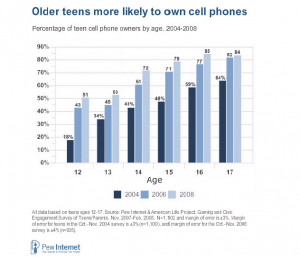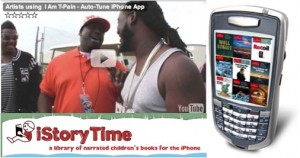
This week's reblog is from our friend Anastasia Goodstein, founder of YPulse.com.
Reading Pew Internet's retrospective summary of its teen mobile research over the past five years, I had two thoughts:
1) I am betting their 2010 report shows way more mobile adoption from younger teens, less landline usage, esp. with younger teens of Xer parents who may have ditched the landline (though they admit they only surveyed households with landlines in the past), way higher texting rates and higher percentage of smartphone ownership that may cut across socioeconomic lines (we'll see/should be interesting).
2) There are some basic truths you can glean from reading this research about teens and their phones (outlined below)
Girls Are The Biggest Users Of Voice & Texting On Mobile. Just as they put the "social" in social networking – girls are hypercommunicators. From Pew:
Girls ages 12-17 are more likely than boys to use any kind of phone for voice calling. More than a third (36%) of girls say that they use a landline phone daily, compared with 27% of boys. Similarly, 55% of girls with cell phones talk daily on their cell phone, while 47% of cell phone-owning boys report the same. [they didn't measure how LONG these conversations were, which I bet would draw an even starker gender difference]
Girls are more likely than boys to send and receive text messages frequently, as are older teens ages 15-17. More than 2 in 5 girls (42%) send text messages to friends daily, while about a third (34%) of boys do the same.
Older Teens Use Their Mobile Phones More. Even if tween mobile phone adoption numbers increase, my hunch is that it's being driven by parents just as much as peer pressure out of safety concerns. These parents probably aren't quite ready to give their tweens unlimited plans and still have a heavy hand in controlling how these tweens use their phones. Tweens also aren't driving yet, so they may be doing less communicating around where to meet up, who is picking up whom, etc. From Pew:
The older the teen, the more likely she uses her phone frequently. Older teens use them to talk to friends on a daily basis; younger teens tend to use mobile phones to call pals a few times or less per week. More than seven in ten 17-year-olds with phones talk to friends on their cell phones daily, while just 28% of 12-year-olds with phones say the same. A large percentage of phone-owning younger teens ages 12-14 say that they talk to friends at least once a week – 18% of those ages 12-14 report weekly cell phone use, while 10% of those ages 15-17 do.
Tweens Heart Games. Just as the internet is more about playing games for tweens (vs. social networking), portable gaming devices also reflect this reality.
Mobile gaming devices are owned predominantly by younger teens (those ages 12-14). Two-thirds (67%) of 12-14 year olds own a portable gaming device, compared with 44% of teens ages 15 to 17. The most notable drop occurs at age 14, typically a time of transition between middle and high school for many teens.
- Anastasia Goodstein
The original post can be found here.
Follow the site at twitter.com/ypulse.
For more coverage of the latest trends and developments in mobile technology for youth, check out the Ypulse Mobile Channel.














